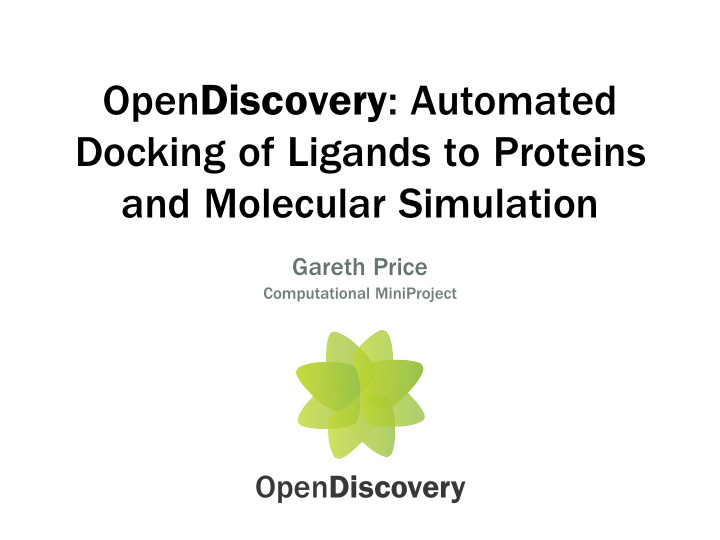



Open Discovery : Automated Docking of Ligands to Proteins and Molecular Simulation Gareth Price Computational MiniProject Open Discovery
Aims + Achievements • Produce a high-throughput protocol to screen a library of chemical compounds against a protein • Use this protocol to produce some putative ligands for chemical synthesis and screening • (Miniproject III) • Paper submitted to ACS JCE • “The use of freely available and Open Source tools for in silico screening in Chemical Biology” • Ground work for OpenDiscovery: • Soon will be found at: www.opendiscovery.org.uk 2
Broad Outline Prepare Files Screen Simulate Parameterise 3
Generating Similar Compounds N SMILES Code CN(C)CCCN1c2ccccc2Sc3ccc(c1)cc13 N Cl Normalise S + Fragment Search against database Give X similar compounds based on Tanimoto distance = 4 character fragments Stepping out of the current chemical “space” 4
SMILES to MOL,MOL2, PDB O HO N[C@@H](Cc1ccc(O)c(O)c1)C(=O)O OH NH 2 HO • oBabel is very useful at converting between chemical fi le formats • and is the most popular tool of choice • Also allows a conformer search, so that the energy minimum can be found • random, weighted or systematic (exhaustive) search • Installs with OBMinimize, an in vacuo minimisation tool 5
PDBQT • Vina actually requires PDB QT • i.e. with atomic coordinates ( PDB ), partial charges ( Q ) and atom types ( T ) • This was achieved by using AutoDock Tools • MGLTools (creators of Vina) provide a python script to do this non- interactively • automate using python/shell scripting • PDBQT fi les for both receptor and ligand Choice between rotatable, non-rotatable and unrotatable bonds
Binding Grid Box Set this to 1 to use Angstrom scaling
Broad Outline Start Similar Compounds Input File SMILES Conformer Search(OBabel) MOL MOL2 Conformer Search(OBabel) Simulate! Solvate PDB (NAMD etc.) psf gen.pgn Minimization(OBMinimize) PDBQT PSF Parameterize Screen! Visualize ligands (VINA) (VMD) Extract Summarize Modes Results 8
Running Vina receptor and ligand fi les www.gprice.co.uk/ads vina --receptor protein.pdbqt output PDBQT with --ligand ligand.pdbqt 1+ modes --out all.pdbqt --center_x 14.45 --center_y -24.772 --center_z 15.079 --size_x 10 box coordinates --size_y 10 and dimensions --size_z 10 � --log log.txt --exhaustiveness 600 exhaustiveness ∝ amount of time devoted to fi nding accurate conformation and position 9
Results • Binding Af fi nity Energies • One PDBQT fi le that has 1+ modes • i.e. a single fi le with the signi fi cant conformations + positions • can’t open in VMD or Chimera • VMD refuses and Chimera opens all modes all at once • but PyMol does work! • Use Scripting/PyMol • (again!)... to extract modes ∆ G binding = ∆ G vdW + ∆ G elec + ∆ G hbond + ∆ G desolv + ∆ G tors 10
AuPoSOM • A relatively new method of clustering docking results • based on contact analysis 8 results_96 results_95 9 _ s results_93 t l u s e results_47 r results_48 results_91 results_99 results_94 results_44 results_43 results_92 results_97 results_101 r e s u l t s 1 0 0 12
Broad Outline Start Similar Compounds Input File SMILES Conformer Search(OBabel) MOL MOL2 Conformer Search(OBabel) Simulate! Solvate PDB (NAMD etc.) psf gen.pgn Minimization(OBMinimize) PDBQT PSF Parameterize Screen! Visualize (VINA) (VMD) ligands Extract Summarize Modes Results 13
A big problem • Most force fi elds only include de fi nitions for amino acid residues • i.e. only bonds etc. found in proteins • Our chemical compound ligands are not proteins • So we need a way to “atom-type” each atoms to a peptide version • …or derive new parameters from ab initio calculations 14
Parameters out-of-plane in-plane Bond Stretching Bond rotation (torsion) Angle Bonding δ + δ - δ + Non-bonded Interactions Non-bonded interactions (Van der Waals) (electrostatic) 15
Gaussian, SwissParam and MATCH • Gaussian is a program that can perform ab initio quantum mechanics calculations • 3 problems: 1. Not all the results will be correct 2. It doesn’t give all values (energies, impropers) 3. It takes ages and extracting information is very manual 16
Amber + Amber Tools • Amber is available for a nominal fee (400$), but their tools are free • antechamber and LeAP are very useful • includes solvation • parameter fi les can also be used in other programs too • Amber is a viable option but it is a long, convoluted process that requires a user who knows what they are doing • compilation, testing and set up of Amber/ Tools is non-trivial -- we need something better (highlighted in our paper) 17
Sample Results 18
Further Work and Acknowledgements • Combine the screening (ODScreen) and parameterisation/simulation (ODParam) with cheminformatics • do we know anything about these compounds already? • do we want to know them? (if there is no information - probably no patent!) • Implement other analysis tools • other than AuPoSOM • I would like to thank MOAC, EPSRC, Dr. Andrew Marsh and Dr. Phil Gould for their support and guidance throughout the project • Also, Dr. Dan Rathbone (Aston), Dr. Alex Simperler (Imperial), Dr. David Bray and Prof. Mark Rodger (Warwick) 19
Software Used • AutoDock Vina* • NAMD* • AutoDockTools* • Gaussian • AutoDockScripter (own • GaussView software) * • ChemNProp* • OBabel* • AuPoSOM* • MacPyMol* • Amber + Amber Tools * • UCSF Chimera* • GROMACS* • Avogadro* • Spartan10 20
Recommend
More recommend